This is our step-by-step guide on how to dehydrate okra.
Actually, we’re going to dehydrate canned cut okra. With canned okra, most of the hard work has already been done.
The canned okra has already been mechanically sliced into dehydrator-sized pieces. There will be no need to process further, nor will there be any blanching required.
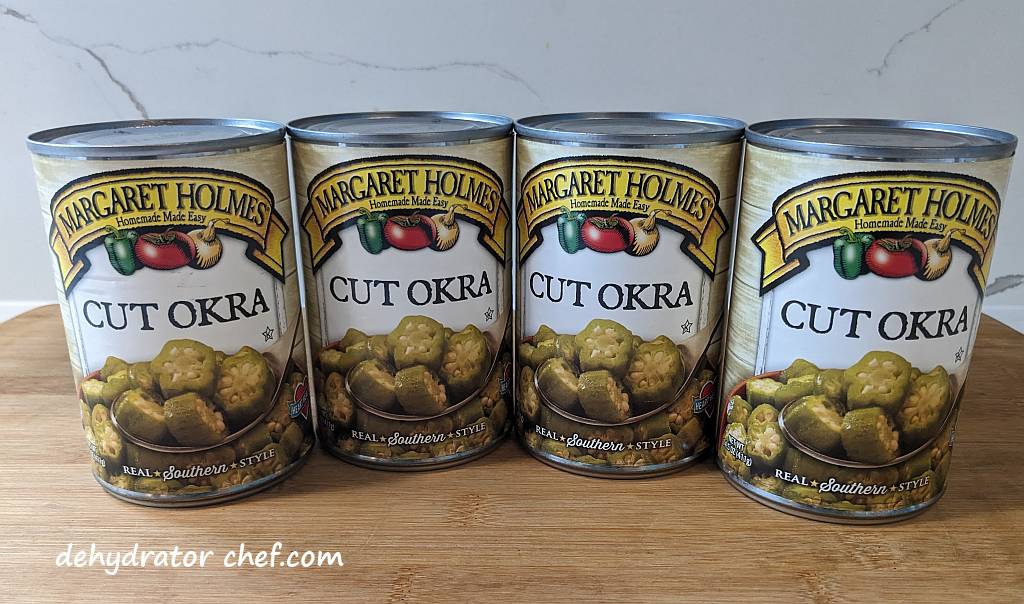
Okra is widely recognized as a vegetable, but since it has seeds, it’s a fruit! Fruits develop from the flower of the plant.
When fruits like cut okra are subjected to heat during the canning process, the pectin in their cell walls starts to break down. This pectin breakdown causes the bonds between the cells to weaken, resulting in the softening of fruits. As the pectin molecules break apart, water is released, further contributing to the soft texture.

The advantage of using canned cut okra in our Dehydrator Chef homemade dehydrated camping meal recipes is that they quickly reconstitute at the same rate as other ingredients, typically around 15 to 20 minutes. Frozen cut okra, when dehydrated, takes significantly more cooking time, so we don’t use it here.
Dehydrating okra is really easy to do, so let’s get started.
Table of Contents
- How to Dehydrate Okra
- Supplies Needed to Dehydrate Okra
- Step 1. Process the Okra for Dehydration
- Step 2. Preparing the Dehydrator to Dehydrate Okra
- Step 3. Dehydrating Okra
- Step 4. When is the Dehydrated Okra Done
- Step 5. Equalizing and Conditioning Dehydrated Okra
- Step 6. Storing the Dehydrated Okra
- Hydration
- Weights, Measures, and Serving Sizes
- Insider Tips
How to Dehydrate Okra
You will need a good quality food dehydrator to dehydrate cut okra. We use the Nesco FD-75A, and you can check out our food dehydrator guide here and why we think Nesco offers the best bang for the buck. We believe this is the best food dehydrator for our long-term food storage needs.
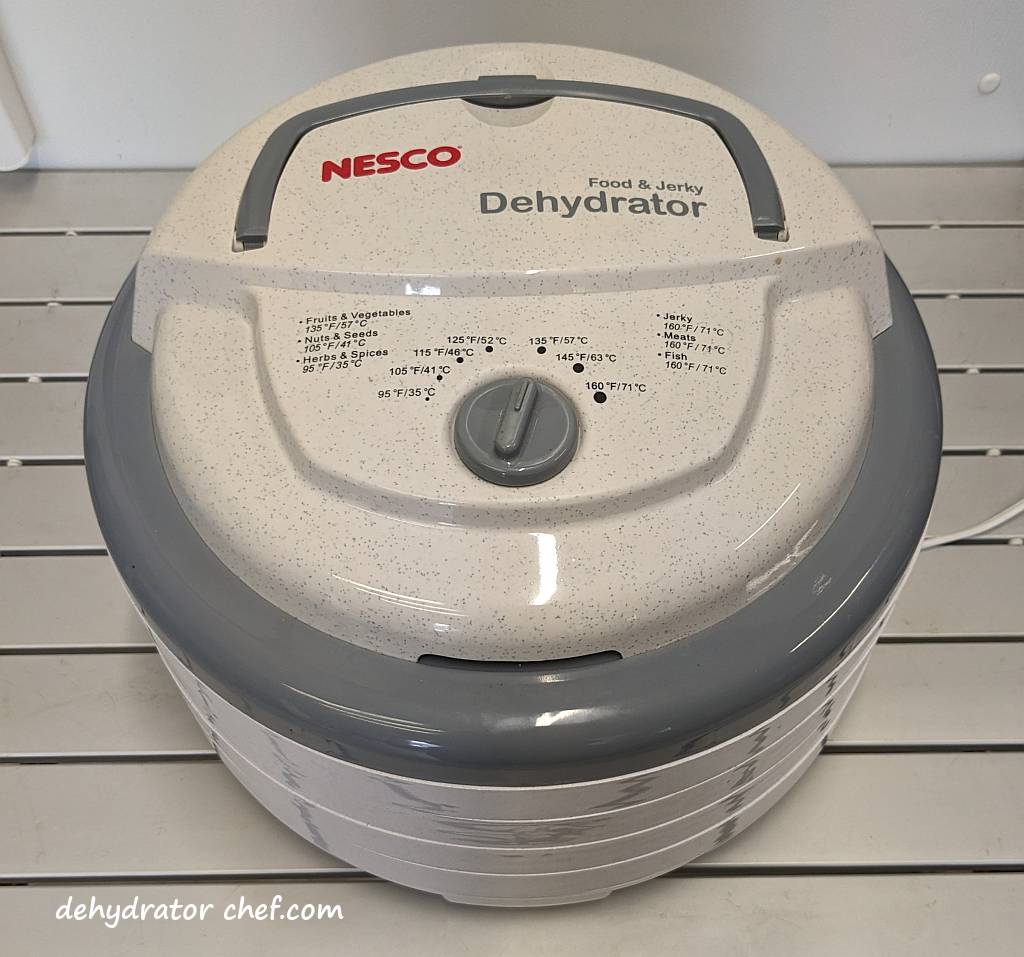
Supplies Needed to Dehydrate Okra
- Food dehydrator
- Removable mesh screen inserts for the dehydrator trays
- Common kitchen tools, including cutting boards, chef’s knife, spatula, etc.
- Clear canning jars with tight-fitting lids
- Wide-mouth canning jar funnel
- Desiccant packets
For planning purposes, one 14.5-ounce can of cut okra fills one dehydrator tray lined with a removable mesh screen insert.
Step 1. Process the Okra for Dehydration
Open the can of cut okra and empty the contents into a mesh strainer or colander. We’ll need to rinse away the salty canning liquid.
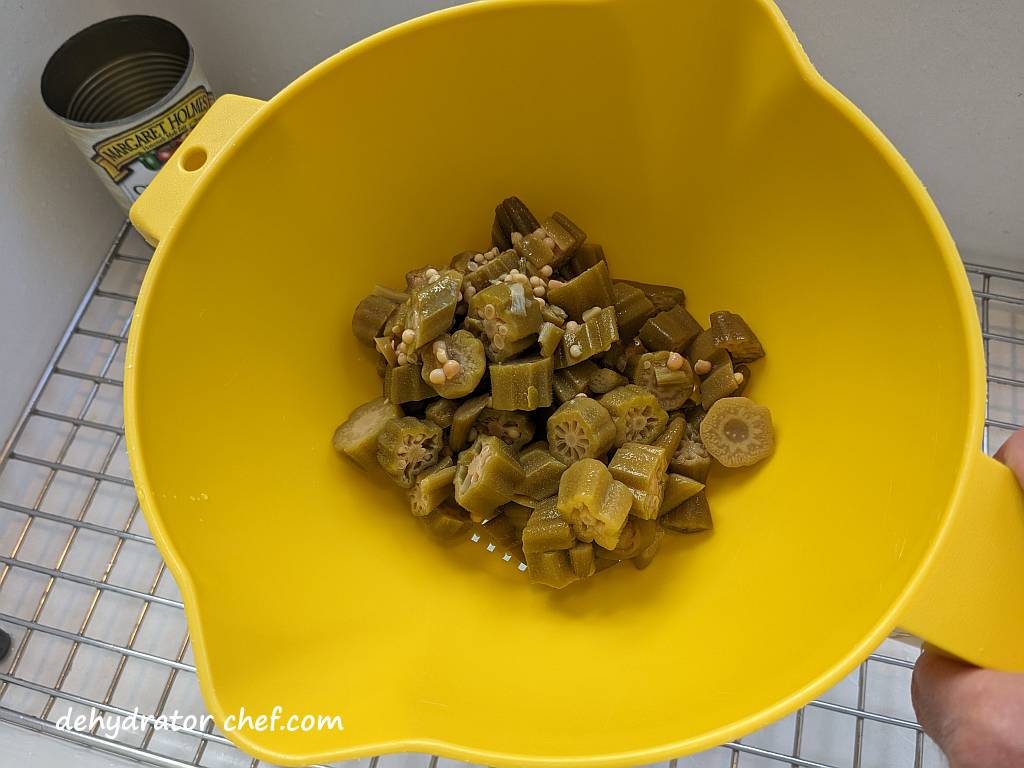
We’re also inspecting the okra for anything that shouldn’t be there. The okra is mechanically sliced. So, you may find bits and pieces you would probably remove if you were doing the processing yourself.
Step 2. Preparing the Dehydrator to Dehydrate Okra
Today, we will use the removable mesh screen inserts on our Nesco food dehydrator trays. One mesh screen insert will be needed for each tray.
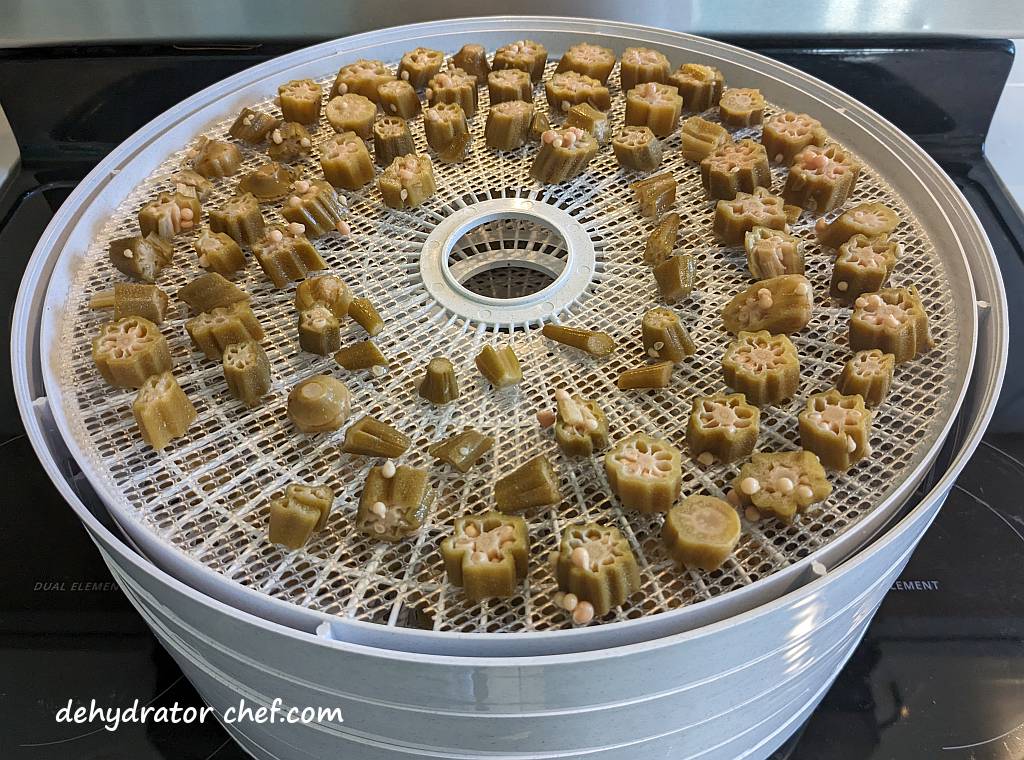
Evenly spread and layer the cut okra pieces onto the mesh screen inserts. If it’s too crowded, prepare another tray. One 14.5-ounce can of cut okra nearly fills one dehydrator tray.
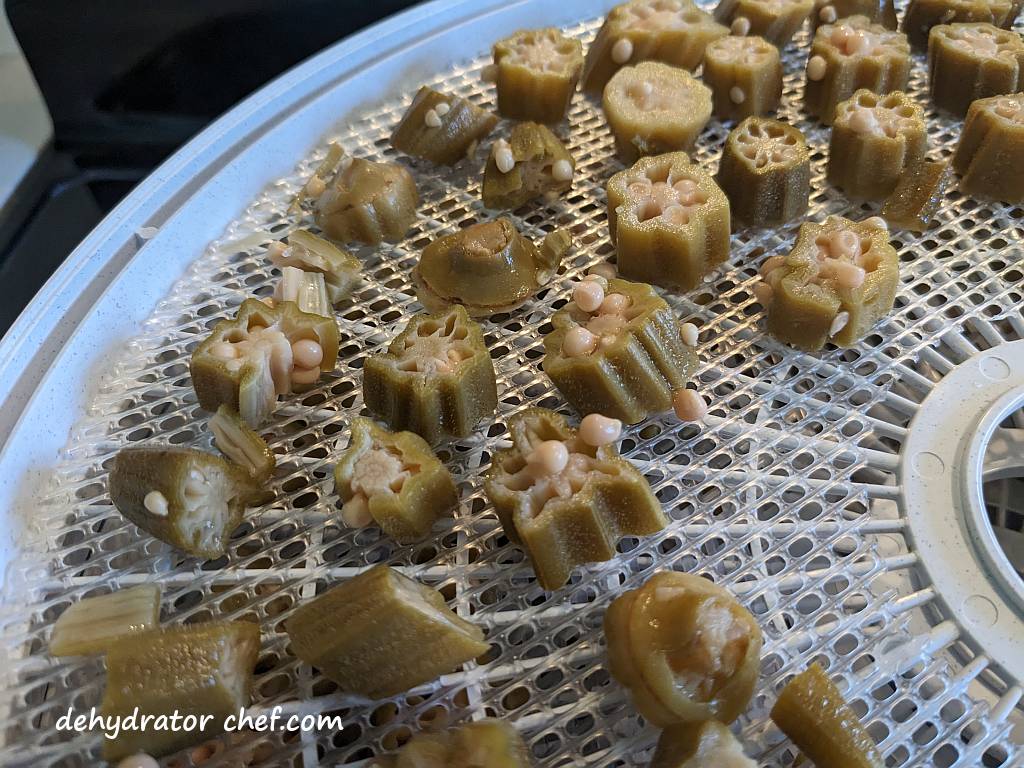
The Nesco 13.5-inch round dehydrator tray has close to 119 square inches or .8 square feet of surface area for drying.
Step 3. Dehydrating Okra
Set the dehydrator thermostat temperature to 135 °F / 57 °C. I find that 8 to 12 hours is about the right amount of time. Drying times are variable and dependent on your food dehydrator, the ambient temperature and humidity, the number of dehydrator trays, the size of food items, and how crowded you fill your dehydrator trays.
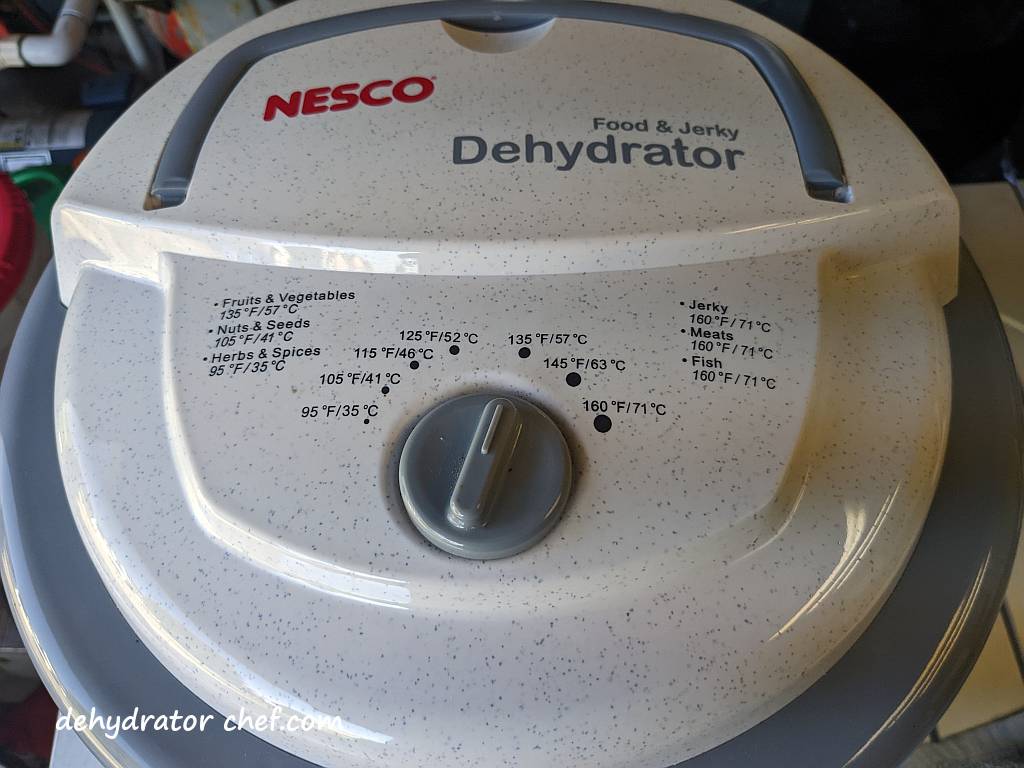
Step 4. When is the Dehydrated Okra Done
Start checking for doneness in 8 hours. Okra usually takes 8 to 12 hours to dehydrate at 135 °F / 57 °C.
Drying times depend on your food dehydrator, the ambient temperature and humidity, the number of dehydrator trays, the size of food items, and how crowded you fill your dehydrator trays. Refer to your dehydrator owner’s manual for recommended temperatures and times for dehydrating specific foods. Remember to use drying times as a guide.
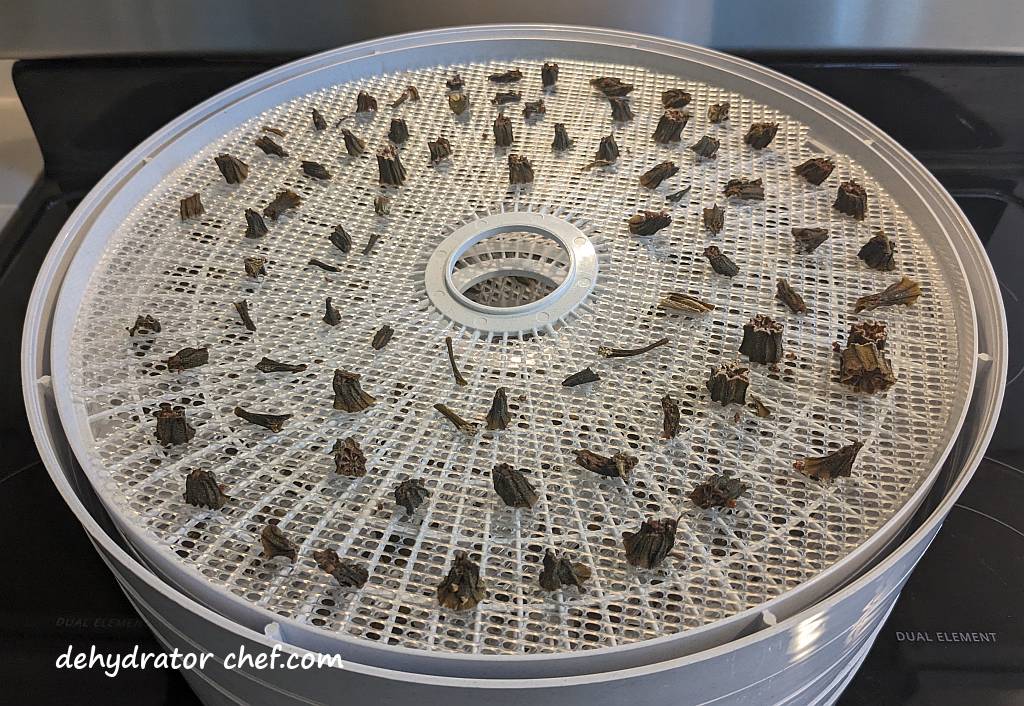
Warm dehydrated okra in the food dehydrator may feel somewhat pliable; you may believe it needs more drying time. Simply unplug the dehydrator or remove the tray and let it cool down. Then check again to be sure. The okra should be crisp or brittle when done.
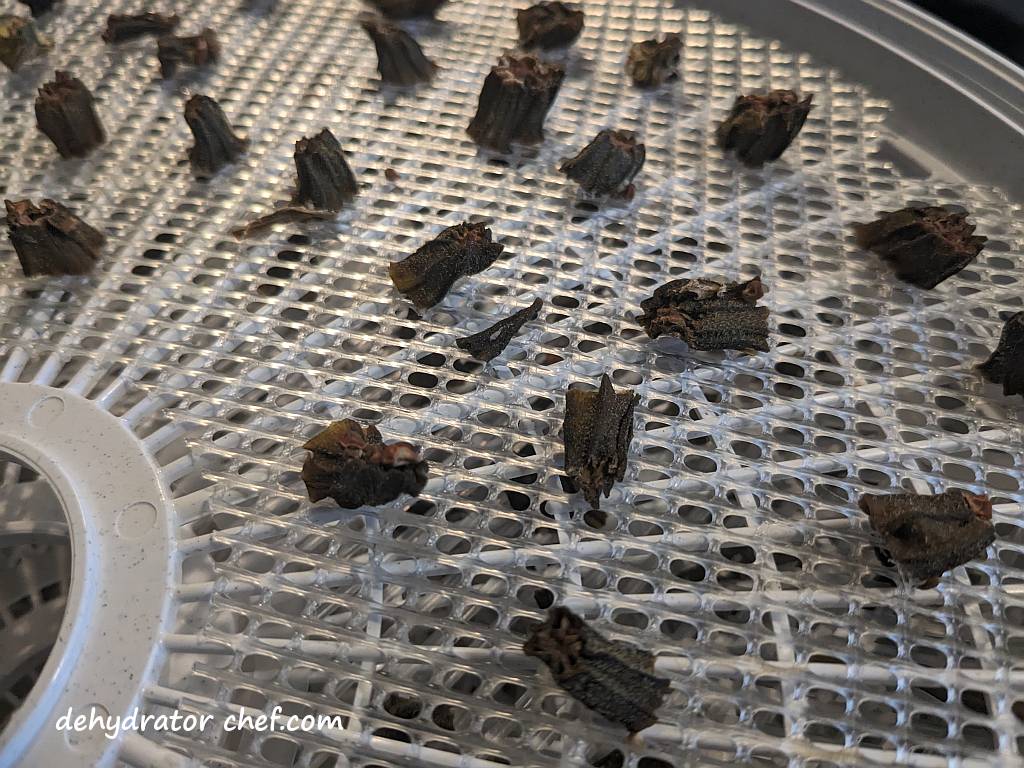
With experience, you’ll develop an eye for dehydration and determining doneness.
Step 5. Equalizing and Conditioning Dehydrated Okra
We always recommend letting food items cool completely after dehydrating and before packing them into an airtight storage container with a tight-fitting lid for equalizing and conditioning. Warm food may cause sweating, which could provide enough moisture for mold to grow.
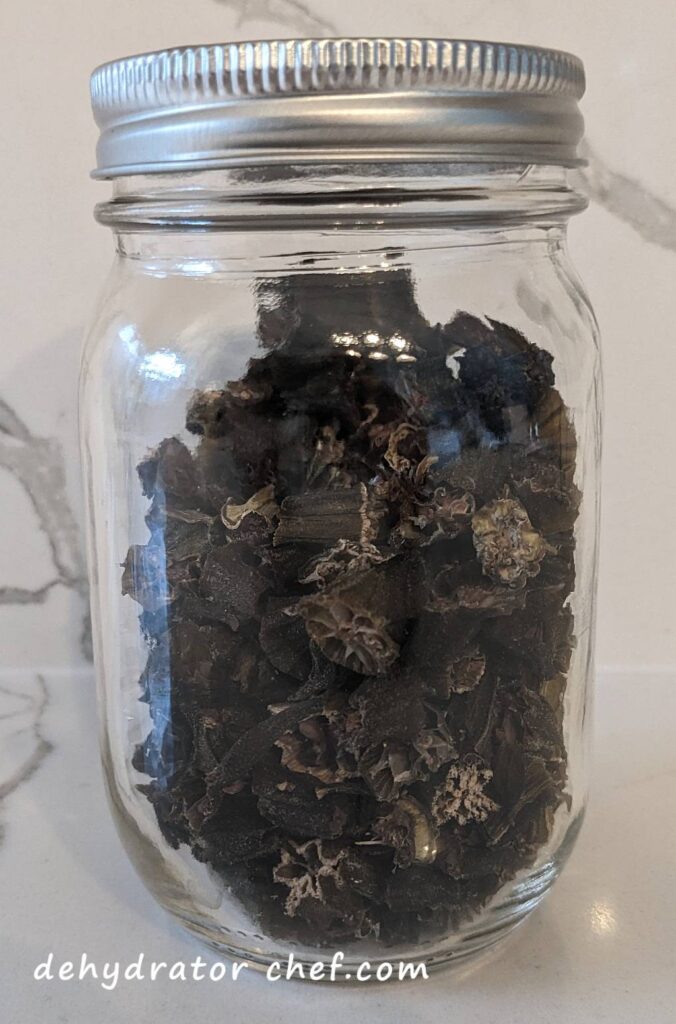
Dehydrated food items do not take long to start hydrating from naturally occurring household humidity. Do not leave dehydrated food items exposed to the elements any longer than necessary because of the increased risk of mold growth.
After a short cooling period, pack the dehydrated okra into clean, dry, insect-proof containers with tight-fitting lids. We’ll use pint- and quart-size canning jars for this task. Fill the jars at most 2/3 to 3/4 full, leaving some headspace.
Headspace is the distance between the food surface and the lid’s underside. Its purpose is to provide ample space for the dehydrated food product to slide and tumble when shaken and rotated to expose any evidence of clumping or sticking.
A quality stainless steel or plastic canning funnel makes the messy job of getting dehydrated foods off the dehydrator tray removable inserts and into the canning jars an easy task. Take a minute or two and check them out here on Amazon.
When the dehydrated okra is removed from the dehydrator, any remaining moisture may not be distributed equally among all the okra pieces because of their size, location, or position in the dehydrator. Equalizing and conditioning is a procedure used for freshly dehydrated foods that ensures any residual moisture remaining in any piece is spread or equalized among all the other pieces in the batch. Let the dehydrated okra equalize and condition in the canning jar for 7 to 10 days.
Every day, check the jar for moisture. Roll the jar contents around and note any clumping or sticking. If seen, put the contents back on the dehydrator for several more hours. Since canning jars are clear, it’s easy to see what’s inside.
Lastly, if you notice any mold, even the tiniest bit, throw it all out. The mold spores you see are blooming enough to make them visible. But there are more, even smaller mold spores in the rest of your jar that make your dehydrated food inedible. Toss it all out and start another batch.
Step 6. Storing the Dehydrated Okra
In the equalizing and conditioning phase in Step 5, we left some headspace so we could easily inspect the dehydrated okra. Now we are in the storage phase, we can now pack the dried okra into clean, dry, insect-proof containers as tightly as possible without crushing. Note, that dried okra will easily crush into bits.
We continue to use clear canning jars with tight-fitting lids as storage containers. They are transparent, making it easy to see the contents. We’re also adding moisture-absorbing desiccant packets. I don’t use a desiccant packet for moisture control during the equalizing and conditioning phase in Step 5. Doing so might mask moisture issues should the food items not be adequately dried.

We use these inexpensive food-safe desiccant packets, which are available from Amazon. These 5-gram packets have over 5000 of mostly 4- and 5-star customer reviews, with an average of 4.7 stars out of 5. Our bag of 60 desiccant packets will last quite a while because they can be recharged and reused multiple times. Other food-safe sizes are available.

I don’t use a desiccant packet for moisture control during the equalizing and conditioning phase in Step 5. Doing so might mask moisture issues should the food items not be adequately dried.
Do not leave your dehydrated food items exposed and unprotected any longer than necessary for the task at hand. It does not take long for dehydrated food items to naturally start hydrating from ambient household humidity. Doing so will increase the risk of mold growth.
Attach or include a short note describing the contents and the date the product was dehydrated. The note also informs us where to go in the dehydrator logbook to make another note.
Hydration
Hydrate the okra using a 3- or 4-to-1 ratio of water to dehydrated okra.
Plan on 15 to 20 minutes to fully hydrate okra in boiling to simmering water.
If you’re supplementing a store-bought freeze-dried meal as we do, just add a tad bit more boiling water to the freeze-dried food pouch. Just use the same 3- to 4-to-1 ratio of dehydrated okra to water. Some freeze-dried meal instructions tend to overestimate the amount of water needed for hydration, so additional water may not be necessary.
Weights, Measures, and Serving Sizes
This information is summarized from the notes we keep in a logbook on most of our food dehydration projects.
One 14.5-ounce / 411-gram can of cut okra fills one dehydrator tray lined with a removable mesh screen insert.
The Nutrition Facts on the 14.5-ounce / 411-gram can show 3.5 servings per container. Each serving is 1/2 cup / 122 grams. The data suggests that this measurement includes the canning liquid.
The contents of the can dehydrate to 14 grams.
We’re not splitting hairs, so we’re rounding the serving count down from 3.5 servings to 3 servings.
| 14.5 ounce / 411 gram can of cut okra | average weights |
|---|---|
| contents, drained | 264 grams |
| three servings, drained | 88 grams |
| total dehydrated weight | 14 grams |
| dehydrated weight per serving | 5 grams |
Insider Tips
Besides the homemade dehydrated meal recipes on this website, try adding dried okra to any of your favorite freeze-dried food pouches for a bit more flavor, bulk, and calories. I don’t know about you, but with some of those store-bought freeze-dried meals, I am still hungry. I need a bit more to fill me up.
Practice these Dehydrator Chef homemade dehydrated camping meal recipes at home several times with the very same outdoor kitchen gear used in the field or at the campsite. This approach lets you practice your skills to know what to expect and where to adapt.
